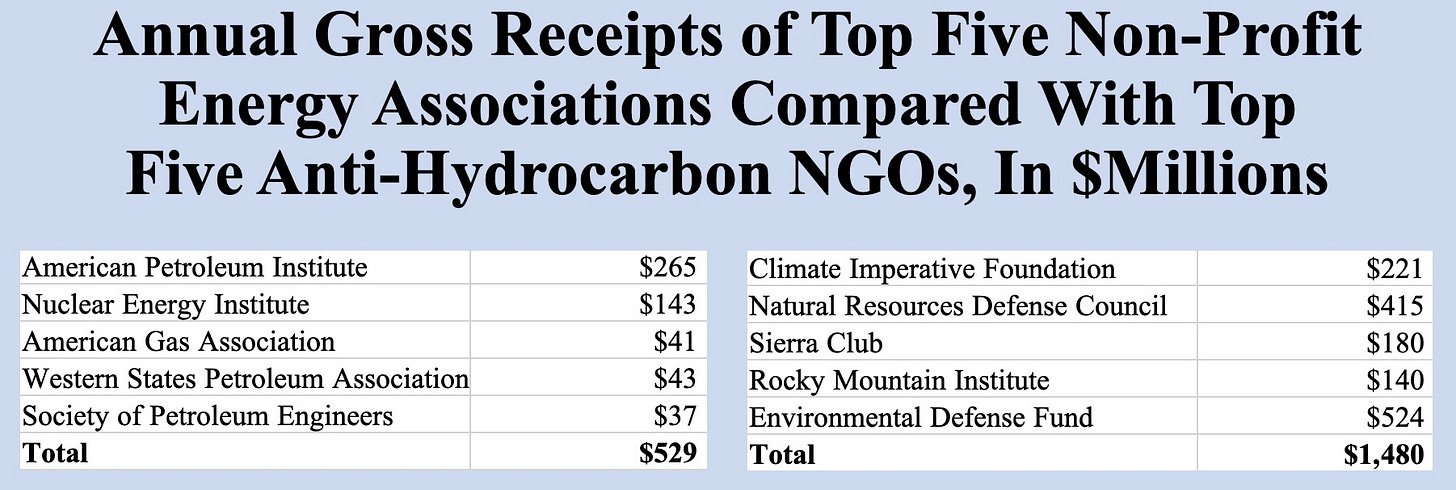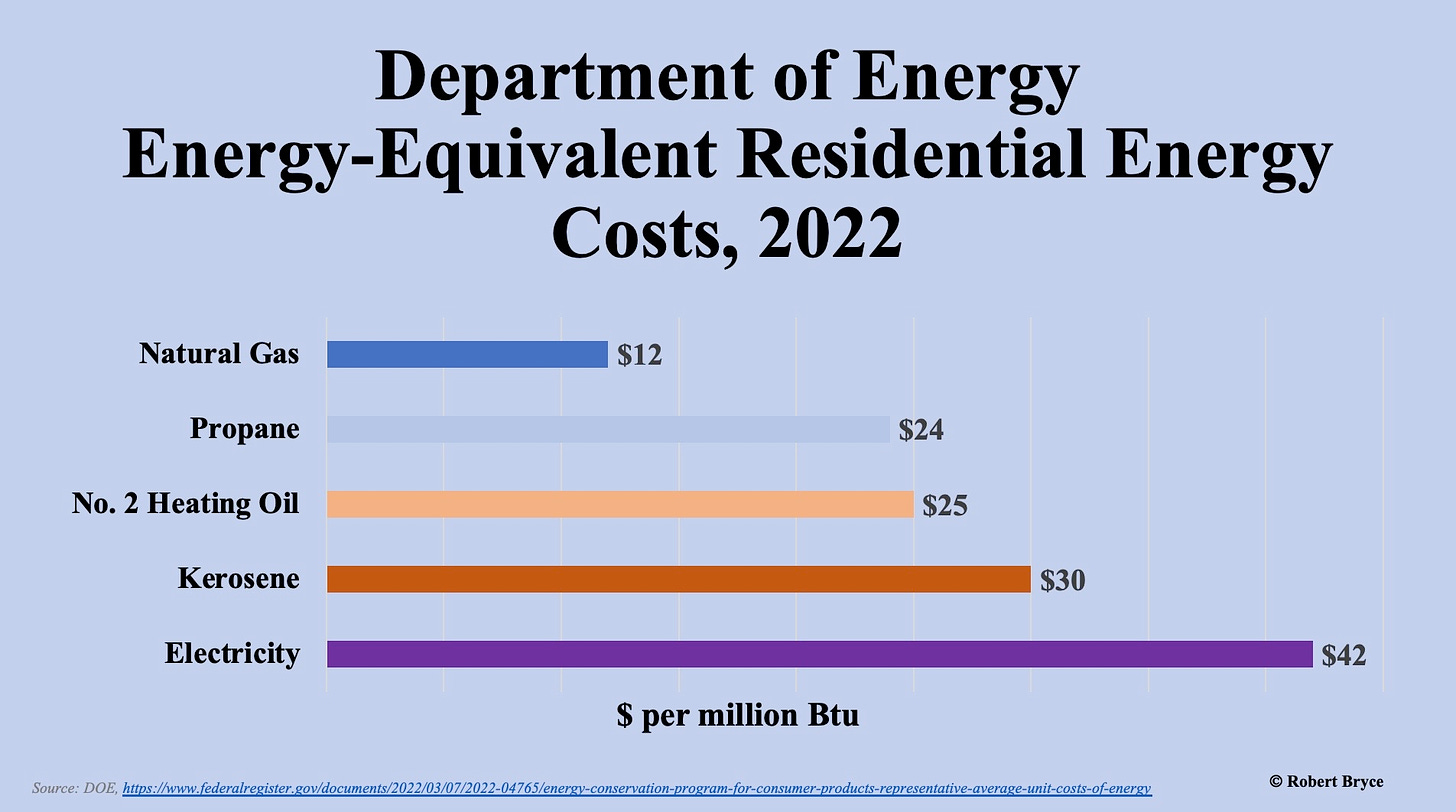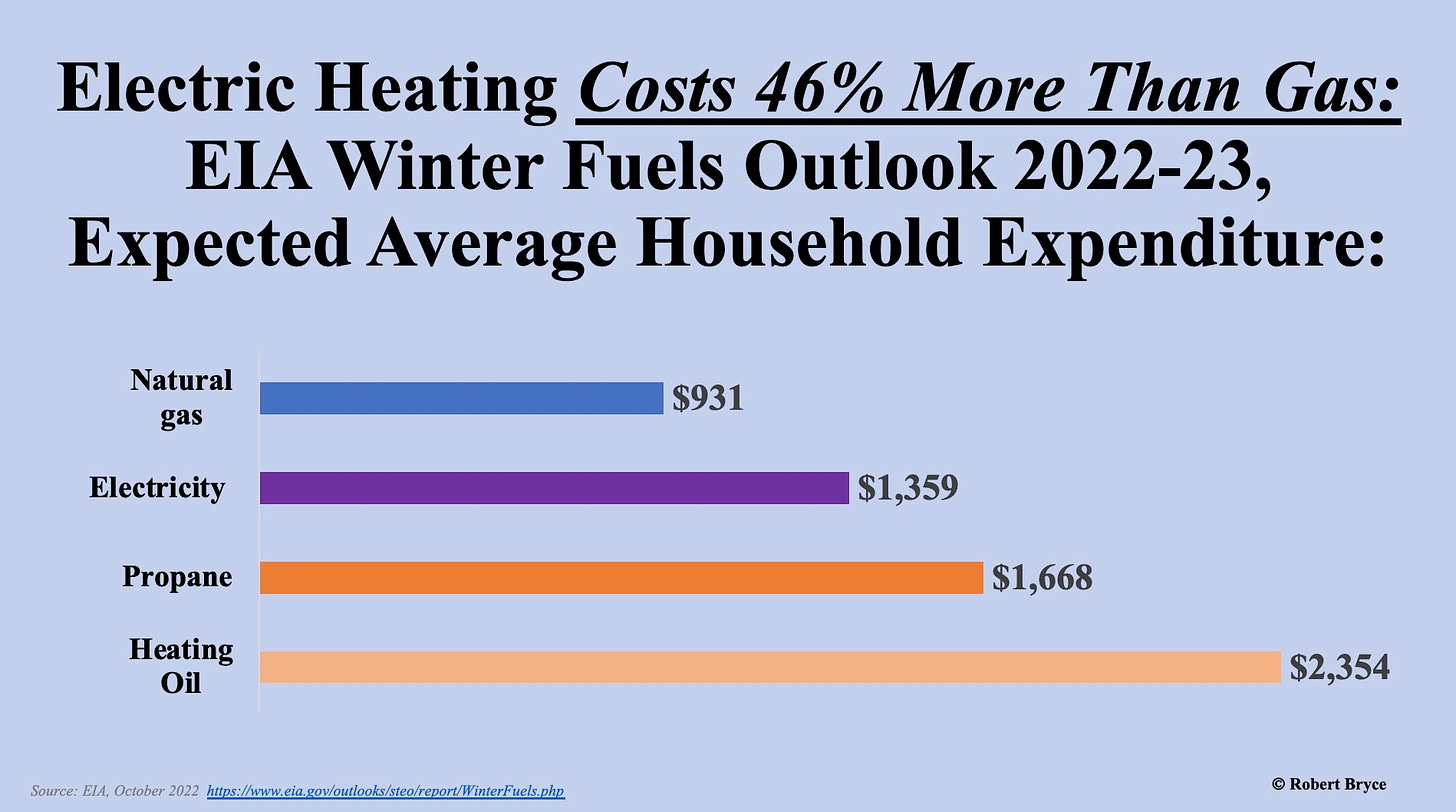https://robertbryce.substack.com/p/the-billionaires-behind-the-gas-bans




The Climate Imperative Foundation is the newest and richest anti-hydrocarbon, anti-natural gas group you’ve never heard of.
How rich is Climate Imperative? According to the latest report from Guidestar, the group took in $221 million in its first full year of operation. (Guidestar calls the income “gross receipts.”) That means that Climate Imperative, which is less than three years old, is already taking in more cash than the Sierra Club, which bills itself as the “nation’s largest and most influential grassroots environmental organization.” According to Guidestar, the Sierra Club collected $180 million in its latest reporting year. Climate Imperative is also taking in more money than the Rocky Mountain Institute which collected about $130 million in its latest reporting year. I use those groups for comparison because they are pushing anti-gas initiatives across the country. More on them in a moment.
The emergence of Climate Imperative — which has received virtually no attention from legacy media outlets — is important for several reasons.
First, it shows that the effort to “electrify everything” and ban the use of natural gas in homes and businesses – and that includes gas stoves — is part of a years-long, lavishly funded campaign that is being bankrolled by some of the world’s richest people.
Second, despite numerous claims about how nefarious actors are blocking the much-hyped “energy transition,” the size of Climate Imperative’s budget provides more evidence that the NGO-corporate-industrial-climate complex has far more money than the pro-hydrocarbon and pro-nuclear groups. Indeed, the anti-hydrocarbon NGOs (most of which are also stridently anti-nuclear) have loads of money, media backing, and momentum. As can be seen in the graphic below, the five biggest anti-hydrocarbon NGOs are now collecting about $1.5 billion per year from their donors. (All data is from Guidestar.) That sum is roughly three times more than the amount being collected by the top five non-profit associations that are either pro-hydrocarbon or pro-nuclear.

Third, banning the direct use of natural gas in homes and businesses may be worse for the climate. You read that right. Burning gas directly allows consumers to use about 90% of the energy contained in the fuel. Using gas indirectly — by converting it into electricity and then using that juice to power a heat pump, stove, or water heater — wastes more than half of the energy in the fuel. That point was made by Glenn Ducat, in his excellent new book, Blue Oasis No More: Why We’re Not Going to “Beat” Global Warming and What We Need To Do About It. Ducat is a Ph.D. nuclear engineer who worked at Argonne National Lab, as well as at two electric utilities. He explains “Burning natural gas by residential commercial and industrial customers is at least twice as efficient and emits about half as much CO2 as processes that use electricity produced from fossil fuels. Converting process-heat applications to electricity before the electricity grid is completely carbon-free will increase CO2 emissions.” (Emphasis in the original.)
I began tracking Climate Imperative in late 2021, when Axios published a story headlined, “climate movement veterans launch major new foundation.” Axios reported that the new group has “a planned budget of $180 million annually over five years.” That number caught my attention. Here was a new group with a planned five-year budget of $1 billion, and yet, Axios was the only media outlet to report on it.
On its website, the group makes it clear that the electrify everything push is a major focus of its work, saying its “imperatives include rapid scaling of renewable energy, widespread electrification of buildings and transportation, stopping the expansion of fossil fuel infrastructure, reducing pollution from major industrial sources, and economy-wide pathways to reduce emissions from the biggest sources.” The website lists some of Climate Imperative’s grantees, a group that includes the Building Decarbonization Coalition and the American Lung Association.
Axios went on to note that the San Francisco-based foundation, “began making grants in the spring of 2020.” It also noted that the group is headed by two former Sierra Club officials: Bruce Nilles and Mary Anne Hitt. Nilles spent more than a decade heading the group’s Beyond Coal campaign. Climate Imperative’s advisory board includes Margo Oge, a former top EPA official, and Bill Ritter, the former governor of Colorado.
Where is Climate Imperative getting its money? The board of directors likely holds the answer. The most recognizable names on the six-person board are Silicon Valley venture capitalist John Doerr and Laurene Powell Jobs, the widow of late Apple CEO Steve Jobs. The other board members include Anita Bekenstein, Sanjeev Krishnan, Greg Nelson, and George Pavlov. A source with knowledge of the group’s funding told me this week that the majority of the money is coming from Doerr and Jobs. Forbes magazine estimates that Doerr has a net worth of $12.7 billion. Forbes puts Jobs’ net worth at $17.7 billion. None of the other board members appear on Forbes’ list of America’s richest people.
The effort to demonize gas stoves began in early 2020, at about the same time Climate Imperative was launched. That year, the Sierra Club claimed that gas stoves are “linked to respiratory illnesses, and children who live in homes with gas stoves are 42% more likely to have asthma.” The source for that claim was a paper by the Rocky Mountain Institute, the Colorado-based non-profit founded by renewable-energy promoter Amory Lovins.
One of the first legacy media outlets to publish an article promoting claims about bad air quality from gas stoves was The Atlantic. In October 2020, it published an article headlined “Kill Your Gas Stove.” It may be a coincidence, but The Atlantic is owned by Laurene Powell Jobs. It’s also interesting to note that in 2018, The Atlantic published a piece titled “How the Gas Oven Changed Humans’ Relationship With Fire,” and noted that the “ability to turn flames on and off at will was ‘one of the single greatest contributors to human happiness in the kitchen.’”
Since 2020, the Rocky Mountain Institute has continued its anti-gas crusade. Earlier this month, a spate of news stories were published after the group released a paper that claimed 12.7 percent of childhood asthmas are due to gas stoves. One of the authors of that paper, Talor Gruenwald, works at RMI. Gruenwald is also a research associate at Rewiring America, a San Francisco-based outfit that calls itself the “leading electrification nonprofit, focused on electrifying our homes, businesses, and communities.” (Rewiring American doesn’t publish a Form 990. It is sponsored by Windward Fund, which took in $273 million in 2021.)
But RMI’s asthma claims don’t stand up to scrutiny. Perhaps the most-definitive analysis of the issue was a 2013 study published in Lancet Respiratory Medicine which studied half a million school children in 47 countries over a multi-year period. It relied on questionnaires filled out by the mothers of children. What did it find? “We detected no evidence of an association between the use of gas as a cooking fuel and either asthma symptoms or asthma diagnosis.”
Furthermore, just a day or two after the RMI paper came out, the group walked back its claim about asthma, with one RMI official telling the Washington Examiner that the study “does not assume or estimate a causal relationship” between childhood asthma and natural gas stoves.
Where does RMI get the money to push its electrification agenda? Some of it is coming from Amazon billionaire Jeff Bezos. In 2020, the Bezos Earth Fund gave RMI $10 million, which the group said will be used to “reduce GHG emissions from homes, commercial structures, and other buildings, enabling RMI to increase its current work with a coalition of partners in key states. The project will focus on making all U.S. buildings carbon-free by 2040 by advocating for all-electric new construction…”
Bezos is also a big backer of the Natural Resources Defense Council, the group that shamelessly bragged about its role in the premature closure of the Indian Point nuclear plant in New York. In 2020, the NRDC issued a press release touting the $100 million grant it got from the Bezos Earth Fund. It said the money “will be used to help NRDC advance climate solutions and legislation at the state level, [and] move the needle on policies and programs focused on reducing oil and gas production…” (Emphasis added.)
The Sierra Club has been a prime beneficiary of former New York City mayor Michael Bloomberg’s Bloomberg Philanthropies, which has pledged $500 million to the Beyond Carbon project. In 2019, the pledge was considered the largest ever “philanthropic donation to combat climate change.” The Sierra Club has been a primary beneficiary of Bloomberg’s giving. About two years ago, a Sierra Club employee told me that it is getting about $30 million per year from Bloomberg. On its website, the group touts its role in the Beyond Carbon initiative, calling it “the largest climate campaign in the U.S., with the goal of closing all domestic coal plants by 2030 and stopping the use of gas as a transition fuel.” (Emphasis added.)
Last August, the Sierra Club asked the Environmental Protection Agency to ban all natural gas appliances at the federal level. The group has had success in getting bans adopted in California. According to its website, 69 communities in the state have now “adopted gas-free buildings commitments or electrification building codes.” In September, the California Air Resources Board voted to ban the sale of all natural gas-fired space heaters and water-heating appliances in the state by 2030. In addition, New York City and Seattle have banned the use of gas in new construction. Massachusetts is also rolling out a new measure that will allow up to 10 communities to ban gas.
The money coming from Bezos, Bloomberg, Doerr, Jobs, and other deep-pocketed donors means that the NGO-corporate-industrial-climate complex can easily outspend the entities that are promoting nuclear energy. For instance, the Nuclear Energy Institute, according to the latest Guidestar numbers, had gross receipts of about $143 million in its latest reporting period. Meanwhile, the top associations that support hydrocarbon producers and distributors — including the American Petroleum Association, American Gas Association, Western States Petroleum Association, and Society of Petroleum Engineers — had combined gross receipts of less than $400 million.
Two final points. The first is the hypocrisy of billionaires funding efforts to slash hydrocarbon use while they are consuming staggering amounts of hydrocarbons. According to a 2020 article in Vanity Fair, Michael Bloomberg owns eight houses in New York state alone, and “he also reportedly owns several properties in London, Florida, Colorado, and Bermuda.” Thus, Bloomberg may own a dozen houses. How many of those houses have gas stoves? I’ll make a wild guess and bet that it’s more than one. Oh, and according to Vanity Fair, while he was mayor of New York, Bloomberg “was known to spend weekends” at his house in Bermuda, “traveling back and forth on private jets.” And what is fueling those private jets? I’m guessing here, but it’s probably not organic quinoa.
Speaking of jets, Forbes recently reported that Jobs owns a Gulfstream G650 (list price about $66 million) that burns about 500 gallons of jet fuel per hour. When not zooming around on her jet, she also spends time on a $120 million yacht called the Venus. Bezos reportedly owns two Gulfstream G-650ERs. After Bezos flew to the 2021 climate meeting in Glasgow, a representative from the Bezos Earth Fund told Business Insider that all was well because the billionaire “uses sustainable aviation fuel, and offsets all carbon emissions from his flights.”
That line puts the hypocrisy of the billionaires funding anti-hydrocarbon initiatives in a nutshell: Bezos, Bloomberg, Jobs, and other uber-rich, hyper-mobile elites can purchase “offsets” for their private jets and mega-yachts, but the shlubs in the barrio can’t be allowed to use a gas stove to cook dinner because, in the words of RMI’s Talor Gruenwald, “Gas stove emissions are significant contributors to the climate crisis.” Never mind that, as the Breakthrough Institute’s Alex Trembath recently noted, that gas stoves account for just 0.4% of total U.S. gas use.

The final bit of hypocrisy at work here is the regressive nature of the gas bans. Indeed, it’s clear that banning natural gas will mean higher costs for consumers. Last March, in the Federal Register, the Department of Energy published its annual estimate for residential energy costs. It found that on a per-BTU basis, electricity costs about 3.5 times more than natural gas. It also found that gas was, by far, the cheapest form of in-home energy, costing less than half as much as fuels like kerosene, propane, and heating oil.
That means that efforts to ban natural gas are, in practice, an energy tax on the poor and the middle class. During a recent interview, Jennifer Hernandez, a California-based lawyer who represents The 200, a coalition of Latino groups that has sued the state over its climate policies, told me that “Natural gas is the last source of in-home affordable energy. And these climate extremists can’t stand it.”
Last October, the Department of Energy provided more evidence that natural gas is the cheapest form of energy for homeowners in its Winter Fuels Outlook. The DOE estimated that heating with electricity this winter will cost about 46% more than heating with natural gas. These numbers show that forced electrification will mean higher energy bills for consumers. Low- and middle-income Americans will bear the brunt of forced electrification because they will have to spend a larger percentage of their disposable income on energy than wealthy consumers.

The bottom line here is obvious: the effort to ban natural gas in homes and businesses is, at root, more about class than it is about climate change.
Over the past several months, I sent several emails to the leaders at Climate Imperative, Mary Anne Hitt and Bruce Nilles, asking about the foundation’s funders, their grantees, their stance on nuclear energy, and the potential cost impact of the electrify everything campaigns on low- and middle-income consumers. I followed up this week with an email to Hitt. She did not reply.
I sent similar questions to Panama Bartolomy, the director of the Building Decarbonization Coalition. His reply: “I will not be responding to your questions.”





